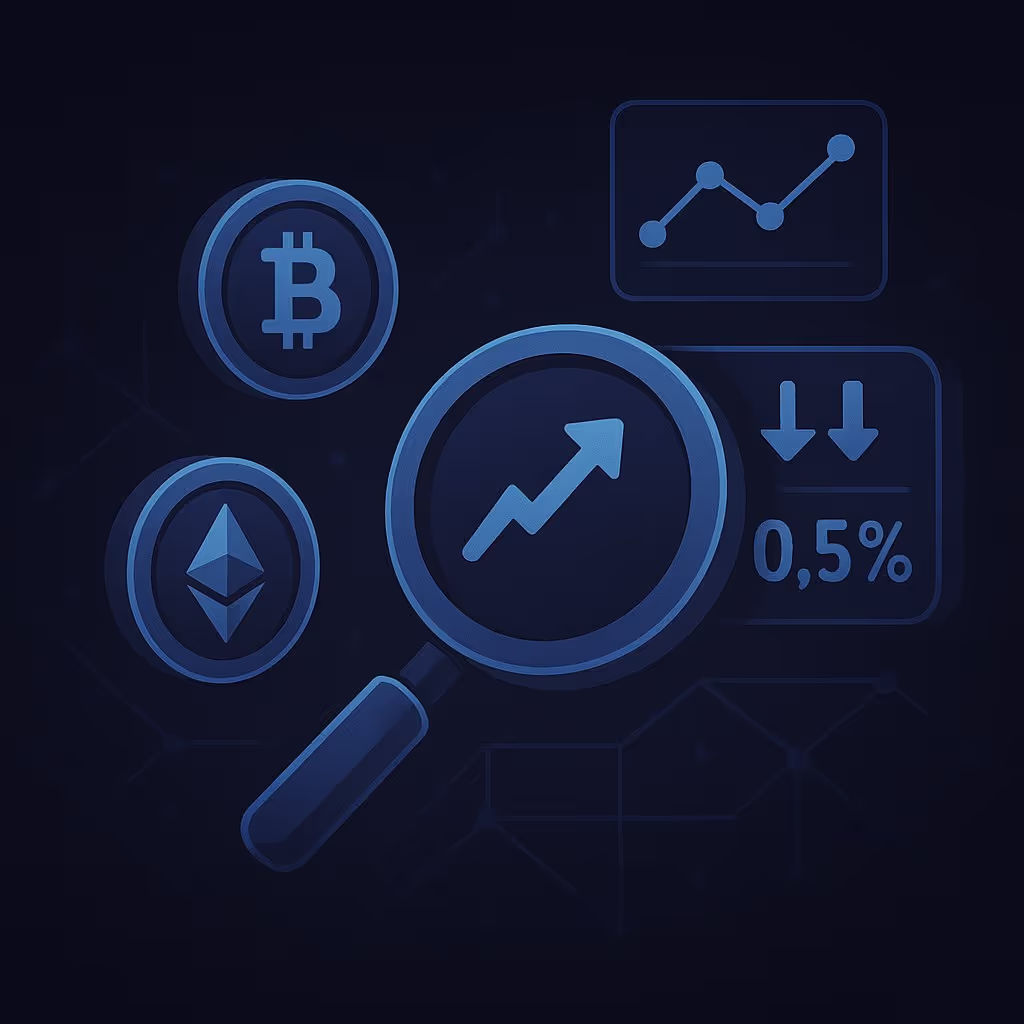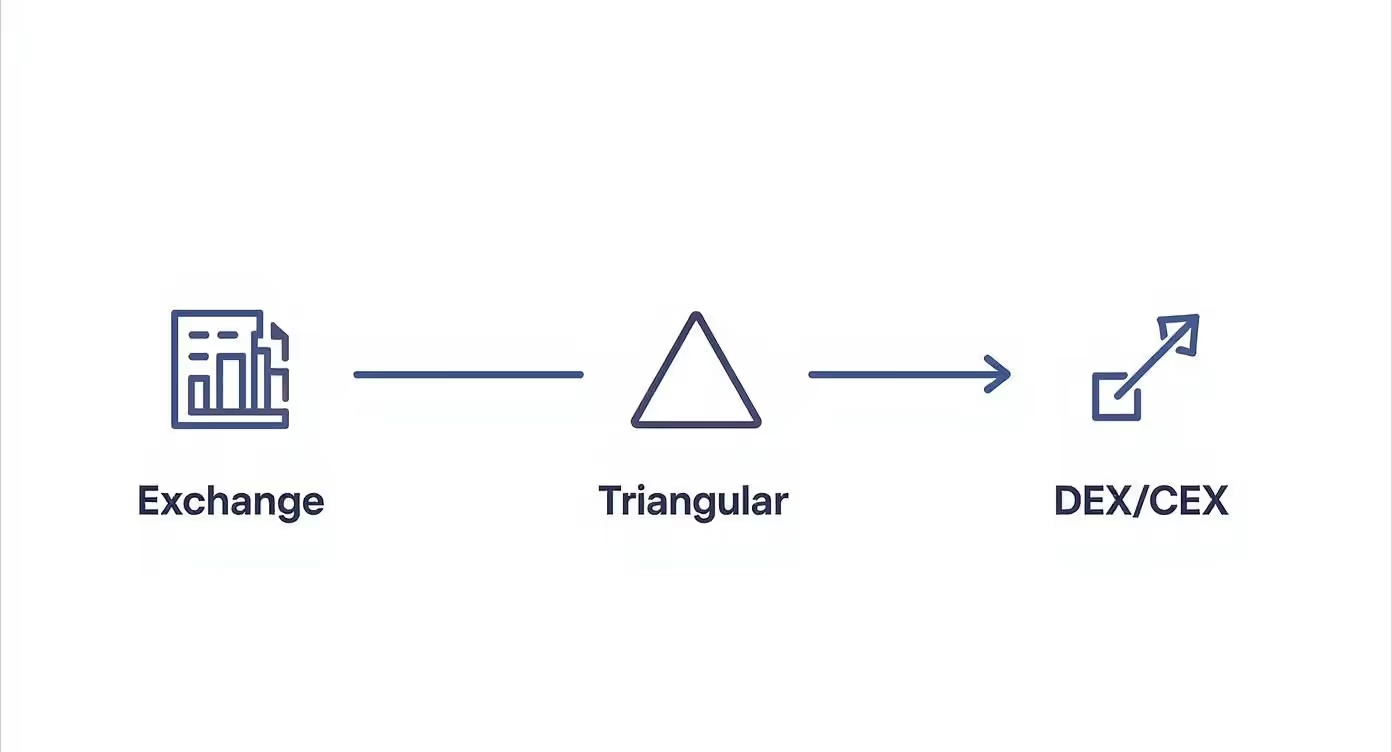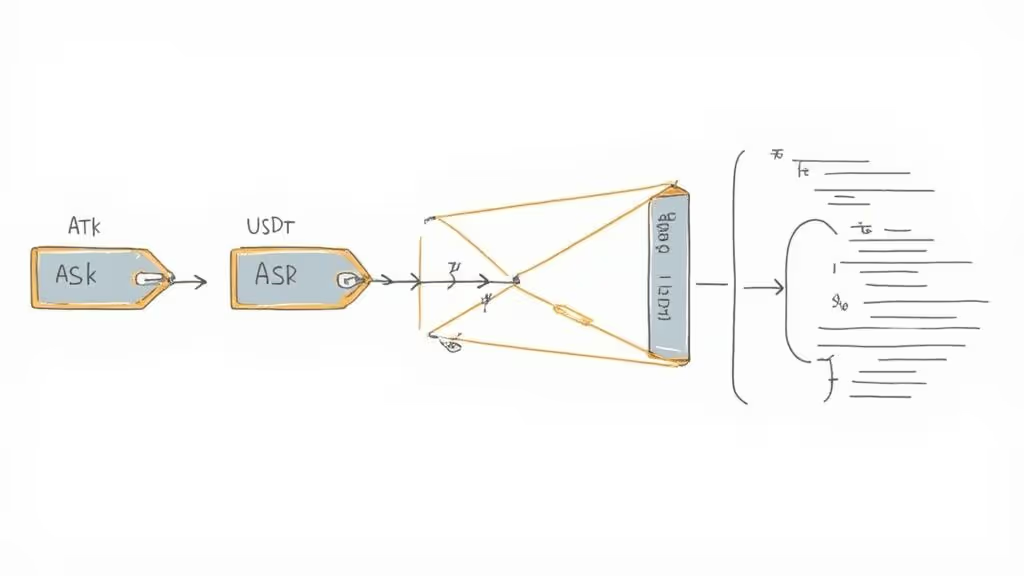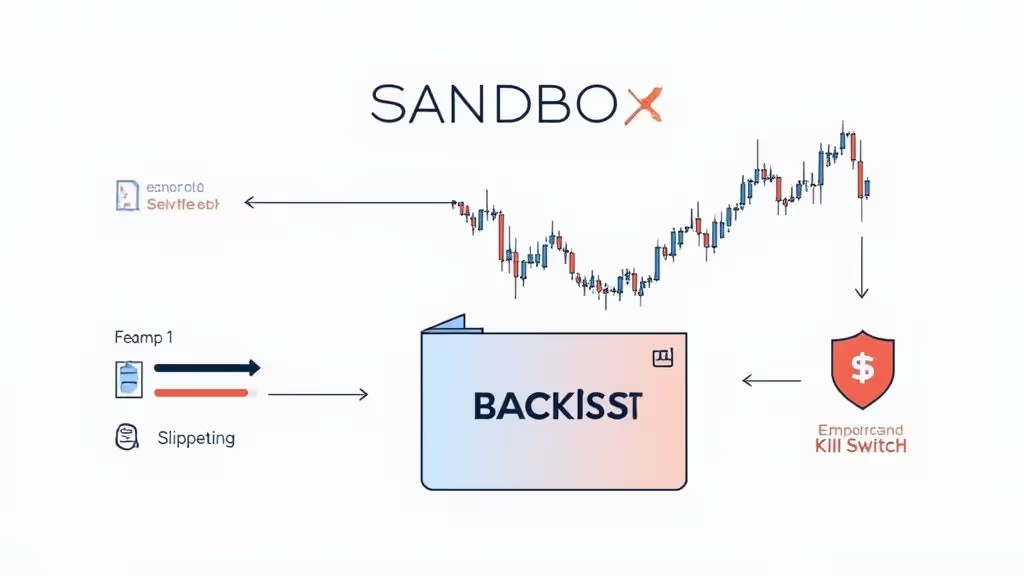Find Your Crypto Wallet Address: A Guide
how to find crypto wallet address: Discover exact steps to locate your address on MetaMask, Coinbase, Trust Wallet, and more, with tips to stay safe.

December 14, 2025
Wallet Finder

November 7, 2025

A crypto arbitrage scanner is your secret weapon for hunting down fleeting price differences across multiple exchanges. Think of it as an automated tool that constantly scours the market, looking for chances to buy a crypto asset low on one platform and sell it high on another. It does this thousands of times per second—a speed no human could ever match.
Before you even think about writing code, you need to get your head around why these opportunities exist in the first place. Price gaps in crypto aren't just random glitches. They're a natural byproduct of a fragmented and wild market. When you build a scanner, you're essentially building a system to systematically cash in on these temporary inefficiencies.
So, what causes them? Here are the primary drivers:
Your scanner's logic needs to be laser-focused on specific types of opportunities. While there are tons of complex strategies out there, most arbitrage plays fall into a few key buckets. It's best to start with the fundamentals.
Let's break down the most common arbitrage strategies your scanner will be designed to find. Each has a unique mechanism and presents a different kind of opportunity in the market.
Arbitrage TypeMechanismExample ScenarioSimple Cross-ExchangeBuying an asset on Exchange A and immediately selling it for a higher price on Exchange B.Your scanner finds BTC is priced at $60,000 on Coinbase but is trading for $60,050 on Kraken. The play is to buy on Coinbase and sell on Kraken.Triangular ArbitrageExploiting a price discrepancy between three assets on a single exchange to make a profit through a circular trade.On a single exchange, you trade BTC for ETH, then that ETH for ADA, and finally trade the ADA back to BTC, ending up with more BTC than you started with.DEX-to-CEX ArbitrageCapitalizing on price differences between a decentralized exchange (DEX) and a centralized exchange (CEX).The price of LINK on Uniswap (a DEX) might temporarily lag behind the price on KuCoin (a CEX), creating a gap you can exploit.
These are the foundational plays. Mastering their detection is the first major step in building a profitable scanner.
The bottom line is that trying to find these opportunities manually is a losing game. The profit windows can last for just a few seconds, sometimes even milliseconds. A well-built scanner is the only way to spot these fleeting chances that are completely invisible to the naked eye.
In today's market, speed is everything. Crypto arbitrage is still a perfectly viable strategy in 2025, but the market has gotten way more efficient, squeezing profit margins down to the bone. This has made manual trading for most of these strategies flat-out impossible.
You’re not just competing against other traders; you're competing against their bots. Sophisticated tools can scan dozens of exchanges across multiple blockchains at once, and that's the level you need to be at. As this trader's guide for 2025 explains, managing fees and execution speed is now critical. An automated scanner isn't just a "nice-to-have"—it's the only way to get the edge you need to compete.
A crypto arbitrage scanner is only as good as the data it eats. Your algorithm can be a work of art, but if it's fed slow, unreliable information, you’re building on a foundation of sand. Designing a high-speed data pipeline isn't just a technical exercise—it's the first real step in turning a theoretical strategy into a system that actually hunts for profit. To understand how to safely manage funds and interact with decentralized platforms, What Is a DeFi Wallet? Your Guide to Web3 Finance provides a clear, beginner-friendly overview.
Think of this architecture as the central nervous system for your entire trading operation. Its job is to take the chaotic, noisy world of crypto markets and translate it into a structured format your scanner can act on in milliseconds.
Your first big decision is where to get your price data. This choice has massive ripple effects on the speed and reliability of your whole setup. You've got a few options, each with its own set of trade-offs.
Data SourceBest ForProsConsWebSocket APIsReal-time CEX price feedsUltra-low latency; data is pushed to you instantly.Can be complex to manage persistent connections; potential for data floods.REST APIsPeriodic data (order books, history)Simpler to implement; good for non-urgent data pulls.High latency; subject to strict rate limiting; unsuitable for live trading signals.Direct Node AccessReal-time DEX data (mempool)The ultimate speed advantage; see transactions before they are confirmed.Technically complex to set up and maintain; requires significant hardware resources.
The visual below breaks down the different kinds of arbitrage opportunities your data pipeline needs to be able to feed.

As you can see, your data ingestion has to be flexible enough to spot opportunities, whether they happen on a single exchange or across multiple platforms at once.
In the arbitrage game, latency is the silent killer of profits. An opportunity that flashes into existence for 500 milliseconds is ancient history by the time your scanner sees it a full second later. Every single millisecond you can shave off your data pipeline is a direct competitive edge.
Your only goal here is to shrink the time between a price changing on an exchange and your scanner detecting it. A difference of just 10-20 milliseconds can be the deciding factor between capturing a profit and missing out completely.
One of the most powerful ways to fight latency is server co-location. This means renting server space in the exact same data center where an exchange houses its own servers. By physically putting your scanner next door to the exchange's matching engine, you cut network travel time down to the bare minimum. If you want to go deeper on this, it's worth analyzing latency in crypto trading patterns to really understand its impact on your bottom line.
Once you have your data sources locked in, you need a system to process all that information. A firehose of raw data is useless; it needs to be ingested, standardized, and analyzed methodically.
Here is a step-by-step actionable plan for your data pipeline:
BTC/USDT from Binance will look different from Kraken's. Your normalization stage must take all this messy, inconsistent data and convert it into a single, clean format that your core logic can easily work with.Alright, you've got a high-speed data pipeline humming along. Now it's time to build the engine room of your crypto arbitrage scanner—the part that turns a firehose of market data into real, actionable trading signals. This detection logic is the brains of the operation, tasked with spotting those fleeting price discrepancies in all the market noise.
We'll start with the most straightforward type of arbitrage and then ramp up to more complex strategies. While each algorithm uses a different mathematical approach, the core goal is always the same: find a circular path for your capital that leaves you with more than you started with, even after paying all the fees.

This isn't a niche hobby anymore. The global algorithmic trading market, which crypto arbitrage is a big part of, is expected to reach around $42.99 billion by 2030. That growth is fueled by sophisticated systems that can spot complex patterns humans would miss entirely.
This is the classic arbitrage play and the easiest place to start coding. The logic is simple: compare the price to buy a coin on one exchange with the price to sell it on another. You're hunting for moments where the ask price (the lowest sell price) on Exchange A is less than the bid price (the highest buy price) on Exchange B.
The basic formula is straightforward:
Profit = (Bid_Price_Exchange_B * Quantity) - (Ask_Price_Exchange_A * Quantity) - Total_Fees
But the real challenge is in that Total_Fees variable. It's not just one number; it's a messy combination of costs you absolutely must account for:
Your scanner's logic needs to be constantly pulling the latest fee schedules from each exchange's API. It has to bake those fees into every single calculation. Skipping this step is the fastest way to watch a "profitable" trade turn into a guaranteed loss.
Triangular arbitrage gets a bit more complex. It all happens on a single exchange, using three different currency pairs to exploit a pricing imbalance. Say you start with BTC and want to end up with more BTC. The trade loop might look something like this:
If the final BTC amount is higher than what you started with, you've found an opportunity. The calculation involves chaining the exchange rates for each pair. For a BTC -> ETH -> USDT -> BTC loop, the pseudocode to check this would be:
Amount_ETH = Start_BTC * Price_ETH/BTCAmount_USDT = Amount_ETH * Price_USDT/ETHFinal_BTC = Amount_USDT / Price_USDT/BTC
If Final_BTC > Start_BTC, an opportunity exists.
Of course, you have to subtract the trading fees for all three trades from your final profit. The good news is you avoid withdrawal fees since it's all on one exchange. The bad news is you're paying three separate trading fees.
Key Insight: Triangular arbitrage opportunities are incredibly brief—often lasting for mere seconds. They pop up from momentary imbalances in three different order books, and other bots pounce on them instantly. This means your data latency and execution speed have to be top-notch.
Mixing centralized and decentralized exchanges is where things get really interesting. This type of arbitrage brings a whole new set of headaches, mostly around liquidity and price impact. On a CEX, you have a nice, clean order book. On a DEX, the price is set by the ratio of tokens in a liquidity pool.
This means your scanner has to grapple with two huge variables:
Effectively analyzing liquidity flows for cross-chain arbitrage is a skill in itself. Your code has to look beyond simple price tickers and truly understand the on-chain environment, treating liquidity as a constantly changing variable, not a fixed number.
To help you decide where to focus your coding efforts, here’s a quick breakdown of the three logic types we’ve discussed. Each has its own trade-offs between simplicity and potential reward.
AlgorithmComplexityTypical Profit MarginKey ChallengeCross-ExchangeLow0.2% - 1.5%Managing withdrawal fees and transfer times.TriangularMedium0.1% - 0.75%Extreme speed requirements and fee calculation across three trades.CEX vs DEXHighVaries widelyAccurately predicting price impact and volatile gas fees.
For most builders, starting with cross-exchange logic is the most practical path. Once you've nailed that down, you can build on your existing framework to tackle the more demanding logic needed for triangular and DEX-based strategies.
Let's be blunt: deploying an untested algorithm with real money is just gambling. Before your crypto arbitrage scanner even sniffs a live market, it needs to go through a brutal trial by fire in a simulated environment. This is where backtesting—running your scanner against historical market data—becomes your single most important risk management tool.
Building a solid backtesting environment isn't about fancy code; it's about creating an honest simulation. The goal is to get a realistic preview of how your logic would have performed in the past, warts and all. A good backtest doesn't just flash potential profits. It shines a harsh light on flawed logic, uncovers hidden bugs, and forces you to confront the real-world costs that can bleed a seemingly great strategy dry.

The heart of your backtesting setup is its data. Garbage in, garbage out. You need high-fidelity, granular historical data that accurately mirrors the market conditions you want to test. This means getting your hands on tick-by-tick order book data, not just simple candlestick charts.
Here is an actionable checklist for setting up your backtesting environment:
For anyone working with on-chain data, building a reliable testing environment comes with its own unique set of headaches. To get a better handle on them, our guide on scalable backtesting for DeFi challenges and fixes dives much deeper into this complex process.
A backtest that only compares entry and exit prices is worse than useless—it's dangerously misleading. Real-world trading is filled with "frictions," which are the costs and delays that systematically chew away at your profits. Your simulation has to account for these with brutal honesty.
The most common failure point I see in new arbitrage systems is underestimating transaction costs. A strategy that looks like a goldmine on paper can instantly become a money pit once you factor in the true cost of execution.
Your model absolutely must include variables for:
Finally, your backtesting phase is the perfect time to validate your scanner's built-in safety features. Think of these as the circuit breakers that protect your capital when markets get chaotic or your own logic goes haywire.
Here are two non-negotiable safety nets to build and test relentlessly:
So, you've built and backtested your arbitrage scanner. The signals are looking sharp. Now for the exciting part: bridging the gap between those alerts and actual, live trades. This is where you decide just how much you want to let the machine take over.
The biggest fork in the road is your execution model. Are you going to run a semi-automated setup, where the scanner just alerts you and you pull the trigger manually? Or are you ready to go fully automated, letting your system trade on its own without any human input?
Honestly, there’s no right or wrong answer here. It all comes down to your comfort level with the tech and your tolerance for risk. Starting with a semi-automated approach is a great way to dip your toes in. It lets you build confidence in your scanner's signals while keeping the final say on every single trade.
But let's be real: in a market where the best opportunities vanish in milliseconds, manual execution is often just too slow. That's where a fully automated system shines, offering near-instant speed. If you're ready for that leap, you'll be looking at integrating with exchange APIs to place market or limit orders programmatically.
Here’s a quick breakdown to help you decide:
FeatureSemi-Automated SystemFully Automated SystemExecution SpeedSlower; you're limited by human reaction time.Near-instant; only bottleneck is API latency.Control LevelHigh; you approve every single trade.Low; the system acts on its pre-set logic.Risk of ErrorProne to manual errors (think fat-fingering an order size).Risk of a code bug causing rapid, unintended trades.Best ForNewcomers building trust in their scanner's logic.Experienced traders who have nailed down their risk controls.
Just spotting a price difference isn't enough to make you money. A truly great arbitrage system doesn't just find more opportunities—it finds better ones. The real secret sauce is in the signal filtering, where you enrich your scanner's raw output with outside data to confirm a trade's potential.
This means layering in other data points to make sure an arbitrage gap is legitimate and not just market noise. For instance, before firing off a trade, your system could quickly check for a sudden spike in gas fees or unusually low liquidity in a DEX pool. Both are huge red flags that could turn a profitable trade into a losing one.
The goal is to create confluence—where multiple, independent data points all scream that an opportunity is solid. You're moving from a simple system that sees a price gap to a smarter one that understands the context around that gap.
One of the most potent filtering techniques is tracking the on-chain moves of proven, profitable traders—what many call "smart money." By keeping an eye on the wallets of top performers, you can see what they're buying and selling in real time.
This adds a powerful validation layer to your scanner. Let's say your system flags a CEX-to-DEX arbitrage for a particular token. Before executing, it could cross-check that signal against a watchlist of smart money wallets using a tool like Wallet Finder.ai. If you see that several of these top-tier wallets have also recently bought that same token on the DEX, it adds a massive dose of confidence to your signal.
This is how you cut through the low-probability noise and zero in on trades that have already caught the attention of successful market players.
The tooling in this space has exploded, especially in 2025. The best crypto arbitrage scanners now cover dozens of blockchains and exchanges, giving traders an incredible edge. As you can read more about these developments, some traders are hitting consistent daily growth by using AI-powered systems to run hundreds of trades a day—a scale that's flat-out impossible for a human. By combining your custom scanner with these broader market insights, you're building a system that hunts for high-probability trades backed by real, observable market momentum.
Even with a solid plan, a few tough, practical questions always pop up when you move from theory to a live, operational system. These are the real-world challenges that can make or break your project. Let's tackle the most common ones head-on.
Yes, but the game has completely changed. The days of finding massive, obvious price spreads are long gone—market efficiency killed those opportunities.
Today, profitability comes from a combination of speed, low fees, and smart niche selection.
A custom-built scanner gives you an edge by letting you target opportunities that larger firms might ignore. Think about newly listed token pairs on DEXs or less liquid markets where automated systems can still find an advantage. The goal isn't a single massive payday anymore; it's about racking up a high volume of small, consistent wins. This demands constant optimization of your code, a relentless focus on minimizing latency, and ruthless management of every single transaction cost.
The top three project-killers you'll face are latency, API instability, and profit calculation errors. Get any of them wrong, and you're done.
First, latency is a constant battle where milliseconds matter. You need the fastest WebSocket connections and highly optimized code just to have a chance. A few milliseconds of delay is the difference between capturing a profit and missing out entirely.
Second, exchange APIs are notoriously unreliable. They have rate limits, become unstable, or fail completely during high market volatility. Your scanner absolutely must have rock-solid error handling and reconnection logic built-in to survive these outages without crashing or, worse, losing money.
Finally, calculating your true profit is much harder than it looks. You have to accurately factor in a complex web of costs:
A single miscalculation here can instantly flip a "winning" trade into a guaranteed loss.
You can technically start small, but it's important to be realistic. Your profit potential is directly tied to your available capital. While you could test a scanner with just a few hundred dollars, the numbers often don't make sense at that scale.
A 0.5% profit on a $100 trade is only 50 cents, which might not even cover your fees. To see returns that are actually meaningful, you should be looking at a starting point somewhere in the $2,000 to $10,000 range.
This level of capital allows for position sizes that can absorb fixed costs like withdrawal fees and still generate a worthwhile profit on small percentage gains. For any cross-exchange arbitrage strategy, remember you'll need to split this capital across multiple exchanges to be ready to trade the moment an opportunity appears.
Ready to elevate your trading signals? Don't just find arbitrage opportunities—validate them with on-chain intelligence. Wallet Finder.ai helps you track smart money movements, see what profitable traders are buying, and get real-time alerts. Start your 7-day trial and turn market noise into actionable signals.
"I've tried the beta version of Walletfinder.ai extensively and I was blown away by how you can filter through the data, and the massive profitable wallets available in the filter presets, unbelievably valuable for any trader or copy trader. This is unfair advantage."
.avif)
Pablo Massa
Experienced DeFi Trader